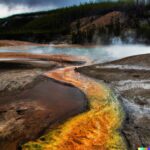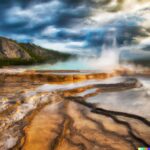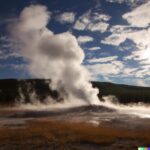Geysers, natural wonders that captivate our imagination with their powerful eruptions of steam and water, have long been a source of fascination for scientists and tourists alike. But what exactly are geysers and how do they form? In this article, we will explore the necessary ingredients for a geyser, where they can be found around the world, the different types of geysers, what causes them to erupt, the phases of a geyser eruption, and how these incredible natural phenomena are studied and monitored.
Get ready to dive into the fascinating world of geysers!
What Are Geysers?
Geysers are fascinating natural thermal features that exhibit periodic eruptions of hot water and steam, often found in geologically active regions like Yellowstone National Park.
These geothermal wonders are formed by underground water reservoirs being heated by magma chambers deep beneath the Earth’s surface. The pressure from the heated water builds up until it forcefully erupts through vents, creating stunning displays of boiling water and steam.
Yellowstone National Park, home to over 500 geysers, is renowned for its high concentration of these natural spectacles, attracting millions of visitors annually. Geysers play a crucial role in the generation of geothermal energy, harnessing the Earth’s heat to produce sustainable power sources.
How Do Geysers Form?
Geysers form through a complex process involving an underground reservoir of superheated water, coupled with a heat source such as a magma chamber, leading to the distinct eruption cycle that characterizes their behavior.
The underground mechanisms behind geyser formation are intricate. High-temperature magma heats the water trapped underground, increasing its pressure and temperature. As this superheated water rises through fractures in the Earth’s crust, it collects in the underground reservoir, waiting for the right conditions to trigger an eruption. The buildup of pressure eventually leads to the explosive release of steam and boiling water, propelling water and steam high into the air. This eruption cycle is a result of the geological processes that contribute to the creation of these natural wonders.
What Are The Necessary Ingredients For A Geyser?
The necessary ingredients for a geyser encompass a combination of water, high pressure within the underground plumbing system, specific minerals like silica, and the geothermal activity associated with tectonic plate movements.
Water plays a crucial role in the formation of a geyser as it seeps into the ground and is heated by the Earth’s internal heat. As this water gets heated, it creates pressure within the plumbing system deep underground. The presence of specific minerals, such as silica, in the underground water plays a significant part in building up the unique characteristics of a geyser. The geological activities linked to the movement of tectonic plates contribute to the formation and maintenance of the underground hot water reservoirs that fuel the geyser eruptions.”
Where Are Geysers Found?
Geysers are found in various parts of the world, with notable concentrations in geothermal-rich regions like Iceland, where they contribute to the formation of geyser basins and support geothermal power plants.
These regions boast a unique combination of geological characteristics, such as high volcanic activity and abundant underground water sources, creating the ideal conditions for geysers to form. Iceland’s geysers, like the famous Strokkur, attract tourists from around the globe who marvel at the natural spectacle of water shooting up high into the sky. The country’s geothermal energy utilization goes beyond just tourism, with geothermal power plants harnessing the Earth’s heat to generate electricity efficiently and sustainably.
What Are Some Famous Geysers Around The World?
Some of the most famous geysers around the world include the iconic Old Faithful in Yellowstone National Park, the impressive Strokkur in Iceland, and the majestic Grand Geyser, showcasing the marvels of geothermal technology.
Old Faithful, known for its reliable eruptions, gained its name due to its predictability, shooting water up to 184 feet in the air. Strokkur, on the other hand, amazes visitors with its frequent eruptions every 6-10 minutes, reaching heights of around 66 feet. These geysers have been studied extensively, leading to technological advancements in geothermal exploration and utilization, allowing for more sustainable harnessing of geothermal energy worldwide.
What Are The Different Types Of Geysers?
Geysers exhibit diverse forms, including cone geysers characterized by distinct vent structures, fountain geysers that spray water vertically, and geyser basins that house multiple geothermal reservoirs.
Each type of geyser showcases unique features and formations. Cone geysers often have narrow cones that build up around the vent due to mineral deposits from the erupting water. In contrast, fountain geysers shoot water high into the air, creating impressive displays of natural beauty. These geothermal reservoirs found in geyser basins play a crucial role in supplying the water and pressure needed for geyser eruptions, which are driven by the interaction between heated water and underlying geological structures.
Cone Geysers
Cone geysers are characterized by a cone-shaped vent structure, formed by the deposition of minerals like geyserite around the eruption site.
This distinctive feature distinguishes cone geysers from other types of geothermal features, such as fumaroles or hot springs. The cone shape is created over many years as mineral-rich water from deep underground is forced upward, cooling and depositing minerals like silica, which solidify around the vent. Geyserite, a type of siliceous sinter, forms intricate patterns on the surface of the cone, adding to its unique appearance.
The process of geyserite formation involves the precipitation of dissolved silica when the hot water cools upon reaching the surface, gradually building up the cone structure.
Fountain Geysers
Fountain geysers are known for their spectacular eruptions that propel a combination of steam and water into the air, often sourced from surface water bodies.
These geysers exhibit unique eruption patterns, with intervals ranging from minutes to hours, depending on the specific geyser. The interplay between the steam and water phases during these eruptions creates a mesmerizing sight, as the water is often superheated underground before bursting forth. This reliance on surface water sources for their periodic eruptions highlights the delicate balance these geysers maintain with their surrounding environment, showcasing the intricate relationship between geological processes and natural water cycles.
Fountain Cone Geysers
Fountain cone geysers combine the features of cone geysers with the eruptive behavior of fountain geysers, showcasing a unique blend of mineral-rich cone formations and high-temperature eruptions near the boiling point.
These geysers typically exhibit distinct cone structures that form as mineral-rich deposits accumulate over time. The mineral compositions found in these cones vary depending on the underground sources, resulting in colorful and textured formations that add to their aesthetic appeal.
The intricate interplay between the water’s boiling point dynamics and the mineral content contributes significantly to the eruption patterns observed in fountain cone geysers. This delicate balance of factors influences the frequency, height, and duration of their impressive water displays.
Geyser Basins
Geyser basins are geologically active regions characterized by sedimentation, mineral deposits, and the potential for harnessing geothermal power from the energy sources present beneath the surface.
These basins, often located in volcanic areas, are created through a combination of groundwater seepage and the presence of magma chambers deep underground. The continuous interaction between the hot magma and the surrounding rocks generates intense heat, warming up the groundwater that eventually surfaces as geysers. As the hot water erupts, it carries along dissolved minerals, such as silica and sulfur, which get deposited over time, forming colorful and intricate mineral formations. The unique conditions in geyser basins make them ideal sites for studying the geological processes that shape our planet and exploring sustainable energy alternatives like geothermal power.
What Causes A Geyser To Erupt?
The eruption of a geyser is triggered by a combination of factors, including the presence of a heat source, an intricate underground plumbing system, and the circulation of pressurized geothermal fluid within the system.
This fascinating natural phenomenon begins with a heat source deep beneath the Earth’s surface, typically magma chambers or other volcanic activity, heating water in underground reservoirs. As this water heats up, it expands and rises through narrow fissures in the Earth’s crust, creating a network of channels known as the plumbing system. The geothermal fluid, enriched with dissolved minerals and gases, builds up pressure as it travels upwards, seeking release through a vent at the surface. When the pressure becomes intense enough, it triggers the spectacular eruption of the geyser, propelling scalding water and steam high into the air.
Heat Source
The heat source for geyser eruptions is typically associated with underground features like a magma chamber, contributing to the geothermal gradient that heats the water within the reservoir.
This connection to underground volcanic activity plays a fundamental role in sustaining the thermal energy required for geyser eruptions. Magma chambers located deep beneath the Earth’s surface create immense heat, which gradually transfers to the surrounding rock layers through conduction. This process sets in motion a geothermal gradient, where the temperature increases with depth. As the heat rises to the surface, it warms the water within the geyser reservoir, eventually reaching a point where the water transforms into steam and triggers the spectacular eruption.
Underground Plumbing System
The geyser’s underground plumbing system plays a crucial role in maintaining pressure levels and facilitating the hydrothermal circulation necessary for the cyclic eruption patterns observed.
These systems are designed to manage a delicate balance of forces within the geyser, as the pressure regulation mechanisms help prevent premature eruptions and maintain the right conditions for periodic releases of steam and hot water. The hydrothermal circulation dynamics involve a complex interplay of heat transfer, convection currents, and water pathways deep beneath the surface. Structural elements such as fractures, conduits, and reservoirs also govern the flow of water and steam within the geyser, influencing the timing and intensity of its eruptions.
Pressure Buildup
Pressure buildup in the geyser system leads to the superheating of water, driven by the geothermal gradient that creates the conditions for explosive eruptions.
As water seeps into the fractures and crevices below the earth’s surface, the geothermal heat gradually warms it up. This superheating process occurs when the water temperature surpasses its boiling point without actually boiling due to the high pressure conditions. As pressure continues to accumulate within the geyser system, the water becomes increasingly primed for a sudden release. Once the pressure reaches a critical point, the geyser erupts, unleashing a powerful display of steam and water propelled upwards in a spectacular moment of natural force.
What Are The Phases Of A Geyser Eruption?
A geyser eruption consists of distinct phases, starting with the dormant phase, transitioning through the preplay and main phases, and concluding with the postplay phase as the geyser returns to a resting state.
During the dormant phase, the pressure beneath the geyser builds up as water and steam accumulate. This period is characterized by a lack of visible activity on the surface, giving an illusion of calmness.
As the pressure reaches a critical point, the geyser enters the preplay phase, where small eruptions begin to occur intermittently, foreshadowing the upcoming main event.
In the main phase, all the stored pressure is released explosively, propelling a towering column of scalding water and steam into the air, creating a spectacular display of nature’s power.
Dormant Phase
During the dormant phase, a geyser exhibits periods of inactivity based on its unique periodicity, reflecting the underlying geological processes that govern its eruption cycles.
These periods of inactivity can vary widely, ranging from days to even years, depending on factors such as underground water levels, thermal energy build-up, and the interplay of surface and subsurface geological structures.
The periodicity of geyser eruptions is often influenced by the intricate interactions between magma chambers, hydrothermal systems, and the presence of constraining fractures in the surrounding rock formations. This delicate balance of forces determines when a geyser will awaken from its slumber and burst into a spectacular display of geothermal activity.
Preplay Phase
The preplay phase of a geyser eruption involves the gradual buildup of pressure within the underground system, often accompanied by heightened volcanic activity in the vicinity.
As the pressure continues to mount beneath the earth’s surface, various indicators start to emerge, such as increased seismicity, rising temperatures in the surrounding area, and the expulsion of steam and gases from vents. These signs serve as warnings of the impending eruption, giving researchers and authorities crucial time to monitor the situation closely and implement safety measures.
Preparatory activities during this phase may include conducting thorough risk assessments, establishing evacuation plans, and issuing warnings to the public to ensure their safety in the event of a volcanic eruption.
Main Phase
The main phase of a geyser eruption involves the forceful expulsion of superheated water and steam through the vent, creating the iconic spectacle associated with geyser eruptions.
As the pressure beneath the Earth’s surface builds up, the superheated water and steam find their way through the intricate network of underground chambers and conduits until they reach the constriction point near the surface. Once the pressure becomes too immense to contain, the water bursts forth with great force, propelling into the air in a spectacular display of nature’s power and fury.
The vent structures play a crucial role in directing the trajectory of the eruption, determining the height and spread of the ejected water and steam. The visual and thermal effects observed during this peak moment are a mesmerizing blend of billowing steam, cascading water, and intense heat radiating from the boiling liquid, creating a sensory experience like no other.
Postplay Phase
The postplay phase marks the conclusion of a geyser eruption, characterized by sedimentation and the deposition of mineral-rich residues around the eruption site.
These mineral-rich residues play a crucial role in the formation of unique mineral deposits that shape the geological surroundings of the geyser. Over time, as the water from the eruption evaporates or flows away, the minerals are left behind, gradually building up layers of colorful and intricate mineral formations. These deposits not only add to the aesthetic beauty of the geyser area but also provide valuable insights into the geological processes at play beneath the Earth’s surface.
The interplay of heat, pressure, and minerals during this postplay phase creates an environment conducive to the creation of stunning mineral specimens.
How Are Geysers Studied And Monitored?
Geysers are studied and monitored through various methods, including temperature and pressure measurements, direct observations of eruption behavior, and monitoring seismic activity in the region.
Temperature and pressure data collection play a crucial role in understanding the underlying processes that lead to geyser eruptions. By continuously monitoring changes in temperature and pressure within the geyser system, researchers can gain insights into the build-up of steam and other volatile components beneath the surface.
Direct observations of eruption behavior provide essential real-time data on the frequency, duration, and intensity of geyser eruptions. Seismic monitoring offers valuable information on underground movements and potential disturbances that may influence geyser dynamics.
Temperature And Pressure Measurements
Temperature and pressure measurements play a vital role in geyser monitoring, offering insights into the geothermal gradients, eruption cycles, and the overall behavior of hydrothermal systems.
These measurements are crucial for understanding the underlying processes that drive geyser activity. By monitoring changes in temperature and pressure over time, researchers can track variations in underground fluid movement, detect potential signs of upcoming eruptions, and gain deeper insights into the dynamics of hydrothermal systems. This data not only aids in predicting geyser behavior but also contributes to the broader scientific understanding of geothermal energy sources and the sustainable utilization of geothermal resources.
Observations And Photography
Direct observations and photography provide valuable data for geyser studies, capturing the visual aspects of eruptions and supporting the advancement of geothermal technology.
These observational studies and photographic documentation not only offer insight into the behavior and patterns of geyser eruptions but also serve as crucial tools for scientific analysis. By carefully documenting the changing landscape and activity of geysers, researchers can better understand the underlying processes and environmental factors influencing these natural wonders.
The detailed records obtained through photography help in tracking any variations or anomalies in geyser behavior, aiding in the development of predictive models and preservation of historical data for future reference.
Seismic Activity Monitoring
Monitoring seismic activity around geyser sites aids in understanding the underlying tectonic processes, geological interactions, and potential volcanic influences that impact geyser behavior.
- By analyzing seismic data, researchers can detect movements in the Earth’s crust, providing insights into the shifting plates beneath the surface.
- These movements offer clues about the build-up of pressure and release of energy that can trigger geyser eruptions.
- Understanding seismic events facilitates the identification of fault lines and regions prone to volcanic activity, helping predict potential eruption risks.
- Seismic monitoring also helps in studying the relationship between geyser phenomena and broader geological dynamics, enhancing our comprehension of the intricate mechanisms governing these natural wonders.
Last Updated on February 8, 2024 by Jon Waraas – Originally Posted: February 8, 2024

I’m Jon Waraas, and I’ve been navigating the online world since 2006. By day, I’m the proud owner of some eCommerce gems, and by night, I’m the voice behind the adventures on Waraas.Com.
My heart, however, belongs to the wild beauty of Yellowstone National Park. I’ve got a collection of websites dedicated to sharing the wonders of this natural masterpiece. Oh, and did I mention? I’m currently building my own cabin inside the ghost town of Gilmore, Idaho – a cabin with tales to tell!
When I’m not immersed in the digital realm, you’ll find me lacing up my boots for a good hike or setting up camp under the star-studded sky.




